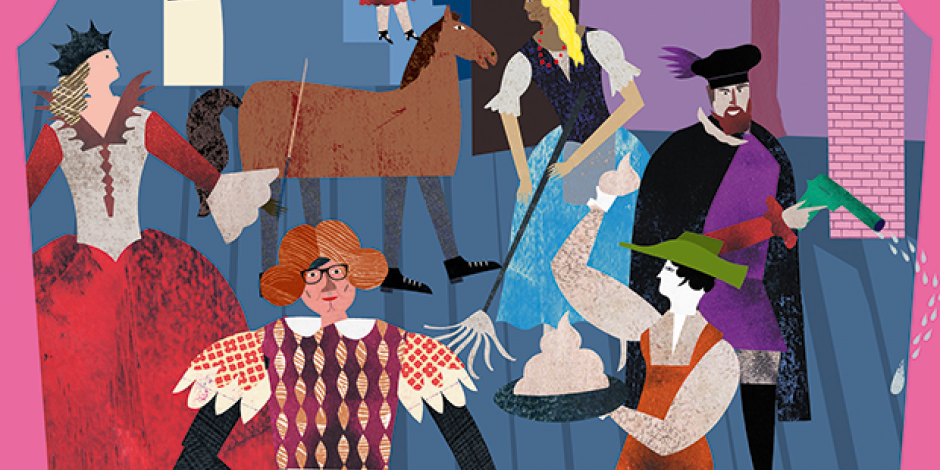What is a pantomime?
pantomime, pantobritisches WeihnachtsmärchenPantomimes are loud, brightly-colouredfarbenfrohbrightly coloured shows, with singing, dancing and general craziness. Most are based on traditional taleGeschichte, Erzählungtales, such as Cinderella or Jack and the BeanstalkHans und die Bohnenranke (engl. Märchen)Jack and the Beanstalk. Every pantomime has certain stock characterStandardrolle, Typusstock characters, with many of the main partHauptrollemain parts given to TV stars.
The absolute star of every panto is the dame, always played by a man in dragin Frauenklamotten, als Frau verkleidetin drag. The dame is usually a widowWitwewidow, and she will to pick on sb.auf jmdm. herumhackenpick on a man in the front row of the audience to flirt with and make jokes about.
The principal boy is the heroHeldhero of the panto and is traditionally played by a young woman in tightsStrumpfhosetights, thigh bootsoberschenkellange Stiefelthigh boots and a short costume. At the end of the play, he marries the principal girl, and they both happily ever afterglücklich bis an sein Lebensendelive happily ever after.
The evilböseevil villain always enters from stage leftlinks vom Schauspielerstage left (the right from the audience’s point of view), whereas the good fairygute Feegood fairy always comes on from stage right. This tradition dates back to medieval timesMittelaltermedieval times, when the two sides of the stage represented heaven and hell.
The pantomime horse (or cow or camel) is played by two actors in one costume. Like all the two-legged characters, the animal has to dance in the grand finalegroßes Finalegrand finale, which is usually a wedding sceneHochzeitsszenewedding scene.
Why is a panto so much fun?
A panto has a lot of physical comedy, or slapstick: people to fall overhinfallen, umfallenfall over, to fall offherunterfallenfall off ladderLeiterladders, get a foot stuck in a bucketEimerbucket and throw custard pies (paper plates full of shaving foamRasierschaumshaving foam) at each other.
There’s always a chaotic chaseVerfolgungsjagd-chase scene. There are silly jokes for the kids, and a lot of sexual innuendoversteckte Andeutung, Anspielunginnuendo and double entendreZweideutigkeitdouble entendre for the adults, as well as topical jokeWitz zu aktuellen Thementopical jokes and parodies of popular songs.
The audience is expected to to participatesich beteiligen, mitmachenparticipate, too — to to booausbuhenboo the the baddiesdie Bösenbaddies, to to cheeranfeuerncheer the the goodiesdie Gutengoodies and to shout out warnings (“He’s behind you!”) and other stock phraseStandardsätzestock phrases (“Oh, yes, it is!” and “Oh, no, it isn’t!”).
At the end, there’s always a singalonggemeinsames Mitsingensingalong, with the audience divided into two teams for a singing battle. The audience is rewarded with sweets thrown from the stage — and squirts of waterWasserspritzersquirts of water, too.
Going to a panto: vocabulary
Click the hotspots in the image to discover the vocabulary. You will find a list with translations below.
1. chorusChor, Tanzgruppechorus
2. pantomime horse (UK)Pferd im britischen Weihnachtsmärchenpantomime horse
3. principal girl (UK)hier: weibliche Hauptrolle im britischen Weihnachtsmärchenprincipal girl
4. villainSchurke, Gaunervillain
5. water pistolWasserpistolewater pistol
6. principal boy (UK)hier: männliche Hauptrolle im britischen Weihnachtsmärchenprincipal boy
7. custard pieSahnetortecustard pie
8. audiencePublikumaudience
9. stageBühnestage
10. sweets (UK)Süßigkeitensweets
11. dame (UK)hier: komische Altedame
12. wigPerückewig
13. costumeKostümcostume
14. fairyFee, Zauberinfairy



